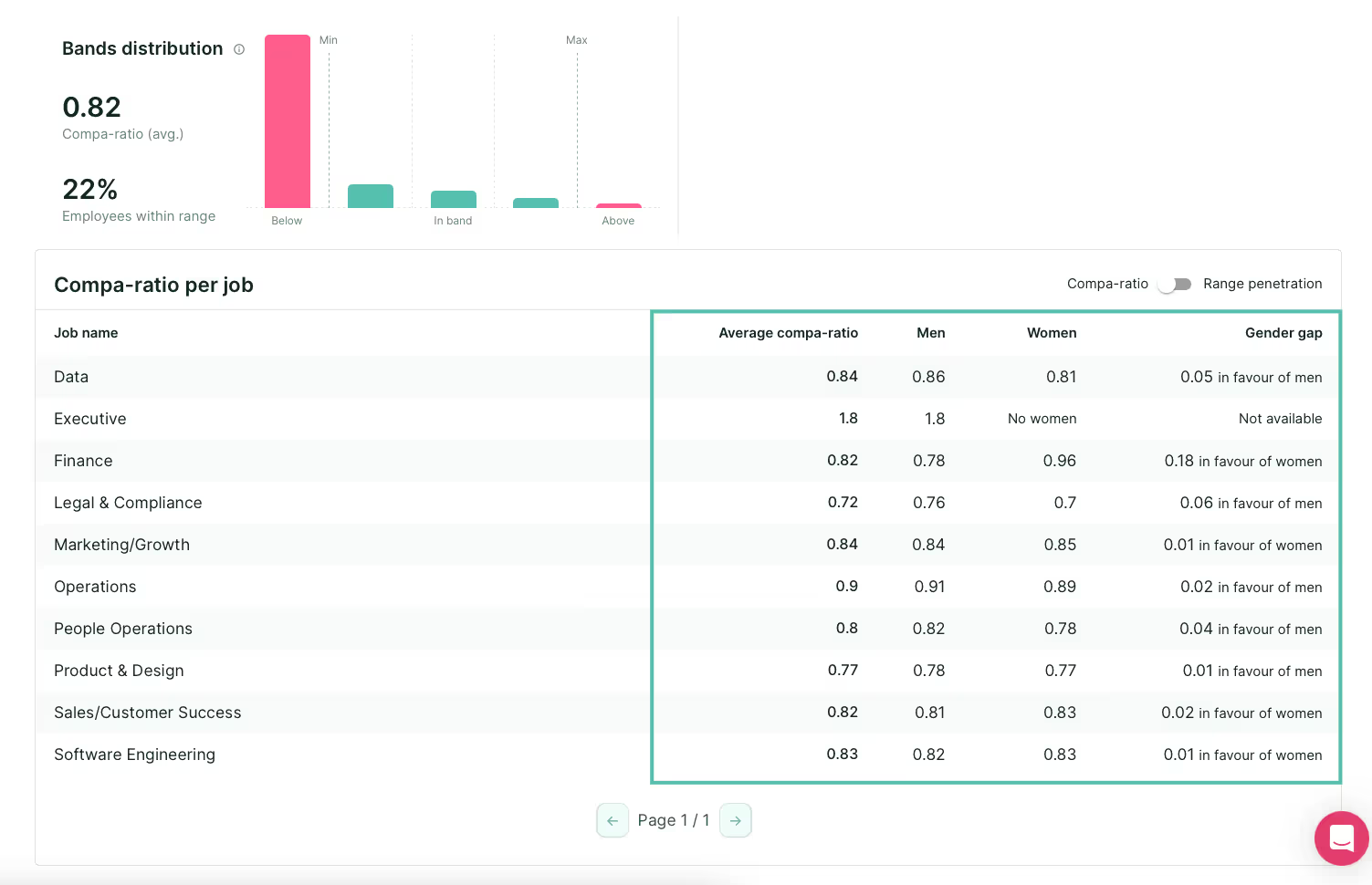Key points:
- Gender pay gaps persist stubbornly, but that's only part of a much bigger equity puzzle affecting all protected characteristics.
- Regular audits = competitive advantage: Companies that conduct annual pay audits experience improved retention, a stronger reputation, and fewer legal headaches.
- It's not just about compliance: While the EU Pay Transparency Directive looms in 2026, smart companies know fair pay drives trust, engagement, and that elusive thing called loyalty.
- Six steps to audit success: From building your dream team to crafting action plans that actually work – we'll walk you through the entire process (no spreadsheet-induced tears required).
- Modern tools beat manual methods: Real-time data and smart analytics transform what used to be a nightmare into strategic insights you can actually use.
Here’s a sobering thought to start your week: according to the OECD, women earn only 87 to every 100 euros a man makes, on average, for full-time workers. And to make matters worse, that number has remained largely unchanged in recent decades.
But gender is just one slice of a rather unappetizing pay equity pie. Across the globe, people face pay discrimination based on race, age, disability, sexual orientation, and other characteristics.
The good news is that there has been progress in that area (albeit not as much as we’d like). For example, Pay Transparency Tools to Close the Gender Wage Gap found that pay gap reporting and equal pay auditing policies help narrow wage disparities across all protected characteristics.
Combine these tools with genuine commitment and close monitoring, and you get something beautiful: a workplace where people are paid what they’re worth, not what unconscious bias thinks they deserve.
Now for the not-so-good news. Ignore pay gaps and you’ll have to deal with legal penalties, reputation damage, and your best talent walking out the door to companies that actually get it.
On top of that, in June 2026, the EU Pay Transparency Directive comes into force, requiring companies with more than 100 employees to report on their pay gaps. In the UK, organisations with 250 or more employees are already required to report gender pay gap data (and if you’re not, well, awkward).
Want to join the ranks of businesses that actually care about treating people fairly? We’ll show you exactly how to conduct an equal pay audit that tackles discrimination in all its sneaky forms, giving you the tools to build an organisation where “equal pay for equal work” isn't just a nice slogan on your careers page.
What is an equal pay audit?
An equal pay audit is a systematic review of how you pay people, designed to spot those sneaky pay gaps that somehow appear between employees doing similar work.
The audit examines whether pay differences have legitimate reasons (like that one person who speaks five languages and has a PhD) or if they stem from less savoury factors (like someone’s gender or race).
Why should you care? Well, besides the whole “being a decent human” thing, pay audits reveal inequalities that would otherwise hide in your spreadsheets like compensation gremlins. Picture this: two employees, same role, similar experience, but one's making 15% less because… reasons?
So, here’s what regular pay audits actually do for your business:
- Build genuine trust – Nothing says “we value you” like actually paying people fairly (revolutionary concept, we know).
- Become a talent magnet – Top performers have options, and they're increasingly choosing employers who walk the fair pay walk.
- Sleep better at night – Fewer discrimination claims mean less time with lawyers and more time doing actual work.
- Keep your best people – Turns out, fairly paid employees don’t spend lunch breaks browsing job sites. Who knew?
- Polish that employer brand – In the age of Glassdoor, your compensation practices are about as secret as your CEO’s LinkedIn posts.
💡 Pro tip: Make pay audits an annual tradition and time them with your compensation review cycle for maximum efficiency and minimum headaches.
📅 Did you know? The UK’s Equal Pay Day marks when women essentially start working for free compared to men. In 2024, that was November 20th, meaning women basically donated six weeks of work. Feeling motivated to fix this yet?
How to conduct an effective equal pay audit in 6 steps
Ready to tackle pay equity head-on? Here’s your roadmap!
1. Form your team
First things first: you can’t do this alone. Well, you could try, but you’d probably end up talking to your spreadsheets by day three.
Instead, build a cross-functional squad that brings different perspectives to the table.
- An executive champion – Someone with enough clout to actually make changes happen (and secure the budget for them).
- Number crunchers – People who see patterns in data, the way others see shapes in clouds.
- Legal eagles – To ensure you’re compliant with regulations (and to translate legalese into human speak).
- Communication pros – Because “we're adjusting your colleague’s salary but not yours” requires some finesse.
Don’t forget to include employee representatives or D&I leaders. They’ll spot blind spots faster than you can say “unconscious bias.”
🧠 Pro tip: Pick a project lead who reports directly to the top. This isn’t the time for middle management maze navigation – you need someone who can walk into the C-suite and say, “We have a problem,” without scheduling seventeen meetings first.
2. Decide the scope and identify goals
Will you audit the entire company or start with specific departments? (Spoiler: starting smaller usually works better, especially if this is your first rodeo.)
Key decisions to nail down:
- Geographic coverage: Just headquarters or every office from London to Luxembourg?
- Employee categories: Full-timers only, or including part-timers, contractors, and that one person who’s technically a consultant but has been here for five years?
- What counts as compensation: Just base salary, or the whole rewards enchilada, including bonuses, stock options, and that gym membership nobody uses?
- Which characteristics to examine: Gender is usually the starting point, but don’t forget ethnicity, age, disability status, and other protected characteristics.
Now for the goals. “Make things fairer” is lovely but about as useful as a chocolate teapot. You need specifics like:
- “Reduce unexplained pay gaps to under 3% within 12 months”.
- “Achieve 100% pay equity for comparable roles by year-end”.
Finally, write it all down. This becomes your North Star when things get complicated. Plus, it helps when someone inevitably asks, “Remind me why we’re doing this again?”
3. Define groups and determine where employees are doing equal work
Here’s where things get interesting – you need to figure out which roles are actually comparable, and spoiler alert: job titles lie.
Your “Senior Marketing Ninja” might be doing the exact same work as a “Marketing Manager” or “Brand Champion” (yes, these are real titles we’ve seen). The key is looking beyond the creative titling to what people actually do all day.
Smart ways to group roles:
- Point-factor systems – Score jobs based on skills, responsibility, effort, and working conditions (less exciting than it sounds, but effective).
- Job families – Cluster similar functions together (all marketing roles, all engineering roles, etc.).
- Grade structures – Group by organisational level (though watch out for inflated titles masking lower pay).
- Market benchmarking – See how the outside world values these roles.
Remember to consider all protected characteristics when grouping:
- Gender
- Race and ethnicity
- Age
- Disability status
- Religion
- Sexual orientation
Here’s the kicker: intersectionality is real. Women of colour often face the biggest pay gaps, dealing with both gender and racial bias. It’s like a terrible two-for-one deal nobody asked for.
4. Collect pay data
You’ll need to pull together comprehensive compensation info for everyone in your audit scope. And yes, “comprehensive” means more than just base salary – we’re talking the full monty of compensation data.
- Base salary – The obvious starting point.
- Variable pay – Bonuses, commissions, overtime, and those mysterious “discretionary: payments.
- Benefits value – Health insurance, pensions, death-in-service benefits (cheerful!), and paid leave.
- The extras – Stock options, company cars, memberships, mental health services, etc.
- Performance data – Ratings, tenure, and whether they’ve won employee of the month.
- Qualifications – Education, certifications, and relevant experience (emphasis on relevant).
- Location factors – Because £50k in London hits differently than £50k in Leeds.
A word about sensitive data: you’ll need info on protected characteristics, but tread carefully. Some employees haven’t disclosed certain characteristics, and that’s their right. Build in voluntary self-identification options while respecting privacy like it’s your own diary from secondary school.
📊 Data quality tip: Validate everything before analysis – even tiny errors can skew results worse than a funhouse mirror.
5. Analyse the causes of pay differences
Now for the fun part – playing detective with your data and going beyond simple averages, which are as useful as a screen door on a submarine.
Patterns to watch for:
- Starting salary syndrome – Do certain groups consistently get lowballed on initial offers?
- Promotion paralysis – Are some groups stuck in career purgatory despite stellar performance?
- Bonus blindness – Is variable pay mysteriously variable based on protected characteristics?
- Geography games – Do disparities cluster in specific locations or departments?
Here’s the crucial bit: distinguishing between explained and unexplained gaps. If someone earns 10% more because they have five years more experience and speak Mandarin (which they use for work), fair enough. But if two people with identical qualifications show a 10% gap that correlates only with gender? Houston, we have a discrimination problem.
Common culprits behind unfair gaps:
- The negotiation penalty (some groups are socialised not to negotiate hard).
- Historical hangovers (old inequities carried forward like bad karma).
- Policy pandemonium (when guidelines are more like suggestions).
- Transparency troubles (mysterious pay decisions breed mysterious gaps).
- The compound effect (small starting differences snowball over time).
For companies serious about pay equity compliance, this analysis phase is make-or-break. Document every finding like your legal team is watching (because they probably should be).
6. Develop an action plan
You’ve found the problems – congratulations! Now you need an action plan that includes both quick wins and long-term fixes.
Immediate fixes:
- Adjust salaries for employees getting shortchanged.
- Implement strategic freezes for overpaid positions.
- Standardise starting salaries with clear pay bands.
Long-term changes:
- Revamp compensation policies for consistency.
- Train managers on bias-free decisions.
- Schedule regular pay equity reviews.
- Create transparent salary ranges.
⏰ Critical deadline alert: Under EU rules, if you report average pay gaps of 5% or more, you’ve got six months to fix them or face joint pay assessments with employee reps.
For those focused on pay equity process planning, remember this is a marathon, not a sprint. Build sustainable processes that prevent gaps from creeping back in.
🔑 Communication is everything: Tell your people what you’re doing and why:
“After years in HR and now helping hundreds of companies tackle pay equity, I’ve learned that the best action plans share one thing: they make pay decisions visible and explainable. When pay decisions happen in daylight rather than behind closed doors, bias has nowhere to hide, and fairness becomes part of your DNA." – Virgile Raingeard, CEO of Figures and ex-HR leader who’s seen it all.
Use Figures’ essential tools to help you close the wage gap
Let’s be honest – conducting pay equity audits with spreadsheets is like trying to perform surgery with a butter knife. Sure, it might technically be possible, but why would you put yourself through that?
Modern pay equity demands modern tools that can actually tell the difference between “Jim has 10 years more experience” and “Jim gets paid more because he’s Jim.” That’s where technology makes the difference between guessing and knowing.
Figures' Pay Equity and transparency solutions turn your compensation data from a confusing mess into clear, actionable insights. Combined with our compensation review tools, you’ll set fair salaries from the beginning and keep them fair as your company grows and evolves.
Here’s what Figures brings:
- Crystal-clear audit trails – Every decision documented, every change tracked. When the auditors come knocking, you’re ready.
- Pattern recognition on steroids – Spot disparities across departments, levels, and demographics.

- Decision support, not just detection – Finding gaps is step one. Figures helps you figure out what to do about them (see what we did there?).
- Communication tools that actually help – Because explaining compensation changes requires more finesse than an email saying “congrats, you got a raise.”
What sets Figures apart is its European expertise. While most compensation tools focus on US regulations and market data, Figures offers country-specific insights across Europe. This means you're comparing pay against real-time peer data from similar European companies, not irrelevant US profiles that don't reflect your market reality.
As a GDPR-compliant platform with ISO 27001 and SOC 2 certifications, Figures ensures all data is processed securely and in full compliance with European regulations.
"Figures has been fundamental in structuring new roles, especially during a major company restructuring," shares Emma Herrero, Director of People and Culture at Phiture. "The ability to quickly access reliable market data, create new bands, and adjust existing ones has streamlined my work significantly."
Start your equal pay audit today with Figures
The truth is, building a fair workplace isn’t something you can tick off your to-do list and forget about. It needs ongoing attention, the right tools, and actual commitment.
With the EU Pay Transparency Directive arriving in 2026, you’ve got two choices: get ahead of the curve now, or join the last-minute panic party later. We know which one we’d choose.
Figures makes the whole process actually manageable – from initial benchmarking to ongoing monitoring. No more defending pay decisions with “well, it seemed fair at the time” or discovering pay gaps through anonymous Glassdoor reviews.
Ready to build a workplace where equal pay isn't just a nice idea but an actual reality? Book a demo and see how Figures can transform your approach to pay equity. Because your employees deserve more than good intentions – they deserve fair pay.






